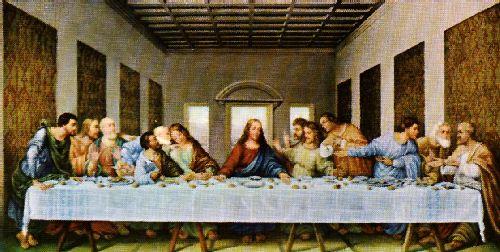Claim: The same person posed for the figures of both Judas and Jesus in Leonardo da Vinci's painting of "The Last Supper."
Examples: [Collected on the Internet, 1999]
A story is told that Leonardo da Vinci painted "The Lord's Supper" when living in Milan. Before he could paint the thirteen figures, it was necessary to find men who could serve as models. Each model had to have a face that expressed 
Leonardo worked feverishly for days. But as the work went on, he noticed certain changes taking place in the prisoner. His face seemed filled with tension, and his bloodshot eyes were filled with horror as he gaped at the likeness of himself painted on the canvas. One day, Leonardo sensed the man's uneasiness so greatly that he stopped painting and asked, "What seems to trouble you so much?" The man buried his face in his hands and was convulsed with sobs. After a long time, he raised his head and inquired, "Don't you remember me? Years ago I was your model for the Lord, Jesus." This miserable man had turned his back on Christ and turned his life over to sin and the world sucked him down to its lowest levels of degradation. He no longer loved the things he had loved before. And those things that he at one time hated and despised, now he loved. Where once there was love, now there was misery and hate; where once there was hope, now there was despair; where once there was light, now there was darkness. When Leonardo da Vinci was painting his masterpiece, The Last Supper, he selected as the person to sit for the character of the Christ a young man, Pietri Bandinelli by name, connected with the Milan Cathedral as chorister. Years passed before the great picture was completed, and when one character only |
Origins: We know so little about the circumstances surrounding
he began "The Last Supper" in 1495 and was finished with it by 1498. (At the outside,
This tale is simply a Christian religious allegory warning of the inner spiritual decay (as exemplified by an outer physical decay) that awaits those who spurn Jesus Christ. As with many other examples of glurge, the writer has housed his message within a historical framework to lend it additional impact, thereby achieving exactly the opposite of what he intended: readers now focus on the literal truth of the allegory's details rather than its message.
The prose version of this glurge bears a strong similarity to the following bit of verse (of unknown origin):
One of a child of beauty rare, The other was a visage vile Side by side in their frames of gold, A youthful painter found one day, Year after year on his wall it hung; Like an angel of light it met his gaze, His raven ringlets grew thin and gray, Through haunts of vice in the night he stayed On a canvas weird and wild but grand, His task was done; 'twas a work sublime — O Crime: with ruin thy road is strewn; The loathsome wretch in the dungeon low,
Two pictures hung on the dingy wall
Of a grand old Florentine hall —
With a cherub face and golden hair;
The lovely look of whose radiant eyes
Filled the soul with thoughts of Paradise.
Marked with the lines of lust and guile,
A loathsome being, whose features fell
Brought to the soul weird thoughts of hell.
Dingy and dusty and cracked and old,
This is the solemn tale they told:
In the streets of Rome, a child at play,
And, moved by the beauty that it bore,
The heavenly look that its features wore,
On a canvas, radiant and grand,
He painted its face with a master hand.
'Twas ever joyful and always young —
Driving away all thoughts of gloom
While the painter toiled in his dingy room.
Bringing him dreams of his boyhood days,
Filling his soul with a sense of praise.
His young ambition all passed away;
Yet he looked for years in many a place,
To find a contrast to that sweet face.
To find some ruin that crime had made.
At last in a prison cell he caught
A glimpse of the hideous fiend he sought.
He painted the face with a master hand.
And angel of joy and a fiend of crime —
A lesson of life from the wrecks of time.
The brightest beauty the world has known
Thy power has wasted, till in the mind
No trace of its presence is left behind.
With a face of a fiend and a look of woe,
Ruined by revels of crime and sin,
A pitiful wreck of what might have been,
Hated and shunned, and without a home,
Was the child that had played in the streets of Rome.
We also found a sighting of the tale (minus claims of the painting being da Vinci's "Last Supper") in a 1979 collection of tidbits and tales meant to be used in sermons:
Years later when the artist was old, the portrait was still there. He had often thought of painting a
A painter once wanted a picture of innocence. He found and painted a little child kneeling beside his mother at prayer. The palms of his hands were reverently folded, mild blue eyes upturned with an expression of devotion and peace. The painter prized this portrait of young Rupert above all else and hung it prominently in his study, calling it "Innocence."
Last updated: 13 January 2008
 Sources:
Sources:
